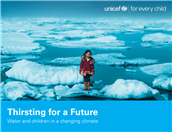Thirsting for a future: water and children in a changing climate
 This report shares a series of solutions, policy responses and case studies from UNICEF’s work around the world. In times of drought or flood, in areas where the sea level has risen or ice and snow have unseasonably melted, children are at risk, as the quality and quantity of water available to them is under threat. When disasters strike, they destroy or disrupt the water and sanitation services that children rely on. As water risks increase, governments and communities need to adapt. Experts and local governments will need better data and evidence on how the availability and quality of water supply is changing as a result of demographic shifts, increasing demands, changing precipitation patterns and increasing temperatures. National water and sanitation policies and strategies will need to make provisions for water risks in order to secure reliable services in communities, homes, schools and health centres. Globally, the discourse about climate change and water stress needs to focus on the most vulnerable groups, such as children, especially girls and children with disabilities, in the communities most affected.
This report shares a series of solutions, policy responses and case studies from UNICEF’s work around the world. In times of drought or flood, in areas where the sea level has risen or ice and snow have unseasonably melted, children are at risk, as the quality and quantity of water available to them is under threat. When disasters strike, they destroy or disrupt the water and sanitation services that children rely on. As water risks increase, governments and communities need to adapt. Experts and local governments will need better data and evidence on how the availability and quality of water supply is changing as a result of demographic shifts, increasing demands, changing precipitation patterns and increasing temperatures. National water and sanitation policies and strategies will need to make provisions for water risks in order to secure reliable services in communities, homes, schools and health centres. Globally, the discourse about climate change and water stress needs to focus on the most vulnerable groups, such as children, especially girls and children with disabilities, in the communities most affected.
